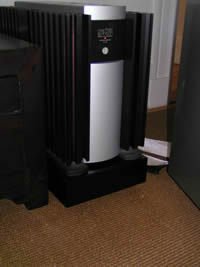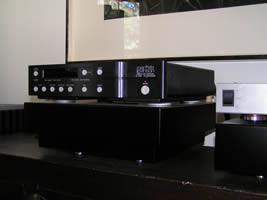Silent Running Audio’s Ohio Class Isolation Platforms
|
Mike Silverton [September 2004.] As a matter of personal interest, those aspects of audio that most fascinate have generated the greatest controversy. I remind the reader who may be unfamiliar with the scene that the late Julian Hirsch typified an attitude. So long as it’s not pushed beyond its operating range, a component that measures well on the test bench will sound no different from another such that measures equally well. A report in Stereo Review detailing an elaborate and excruciatingly fair listening test involving amplifiers from dirt cheap to esoteric-costly would appear to have nailed that coffin lid shut. With respect to designer cables, perhaps the hottest button of all, a handsomely credentialed Ph.D. demonstrated by way of figures and graphs (in Audio? — can’t remember) that zipcord does as good a job. Capping all, we’ve the Stereophile brouhaha Bob Carver provoked in tweaking one of his inexpensive, mass-market amps to sound like a well-respected, and of course high-priced, tubed amp — a Conrad-Johnson, as I recall. The jury was unanimous: that wily old Bob did what he set out to do. The much decried and confounding event was not without its amusements. A reader declared Carver’s coup unethical. One mustn’t mimic and thus make light of a serious amplifier designer’s work. Those were the days. Audio’s once burning issues at best smolder or have turned to ash. The measurements-tell-the-story coterie, its major print forums having succumbed, is close to silent. I don’t mean to suggest that this is a good thing. But it is a fact of life. (As a commendable adjunct to its subjectivist equipment reports — “it sounded like this, it sounded like that” — Stereophile routinely publishes John Atkinson’s test results, with sometimes pungent asides.) As strict objectivism beats its retreat to a smattering of websites, subjectivist audio journalism flourishes, likewise on the Internet. No license exam or advanced degree need impede the urge to declare oneself a golden-ear. Many an attentive listener found strict objectivism wanting; similarly, subjectivism’s disdain of figures and graphs has its drawbacks. The audiophile, discophile and music lover is perhaps no better served by a subjectivist’s impressions than by numbers-tell-the-story reviews. It has been and remains caveat emptor. Your reporter is of course a subjectivist. While I am certainly not identifying myself as a fool or a fraud, as with any audio commentary, I do urge an exercise of caution. I shall do my best to describe SRA’s Ohio Class isolation platforms in as fair and accurate a way as my methodology and biases permit. Aspects of a product lie beyond opinion. Silent Running Audio’s website pictures an Ohio Class platform, along with the company’s other lines, with texts that give an idea of the technology within. What you cannot see in detail is just that, the attention to detail that goes into these pieces. Even among high-end audio designer-manufacturers, Kevin Tellekamp’s fit-and-finish standards are high. My four Ohio Class platforms are as beautifully turned out as my Wilson WATT / Puppy Series 7 speakers, and that’s saying something. Even SRA’s purely functional wood shipping crates are well and thoughtfully made. Remember how Bush looked into Putin’s heart and saw goodness? On rather stronger evidence, I see in Tellekamp a man who loves craftsmanship. Manufactured on demand to conform to the size, weight and weight distribution of the component it supports, an Ohio Class platform is unique among isolation designs. It’s been my understanding that the less expensive VR line conforms to the size and weight of its component, but not to its weight distribution. I emailed Tellekamp for confirmation. His reply and SRA’s website provide some idea of how these units operate.
In his email, Tellekamp has mentioned two product lines I don’t touch on here, the Ohio Class isoBASE XL and Ohio Class isoBASE XL Plus. The website explains the differences. Obviously, given the huge number of high-end audio components on the market, a ready-to-go inventory occupying a vastness of shelves is out of the question. Custom work does not come cheap. Let’s deal first with sticker shock. The Ohio Class platforms under my Mark Levinson 33H mono amps go for $1,023.75USD each. The Mark Levinson 390S CD player’s platform costs $912.50USD, as does the platform under my Reimyo ALS-777 line conditioner. The sum of these pieces buys a not-bad hi-fi. Is Ohio Class worth the expense? The issue is one of commitment — zeal, if you will. I began these remarks with a pinkie-nail survey of audio controversy. Among strict objectivists, isolating solid-state components from vibration might certainly qualify as yet more high-end flummery. Common sense tells us that, yes, effective isolation probably benefits turntables and perhaps even tubed electronics, where microphonics is an obvious problem. Common sense also tells us that the sun circles the Earth.
I have proved to my own satisfaction that my CD player’s performance profits from SRA’s take on isolation. Before an Ohio Class replaced my VR Series CD platform, I listened to a disc with the player directly on the low Chinese cabinet it and the line conditioner occupy and then with the VR Series platform under the player. On another occasion, I made the same comparison with SRA’s generic Tremor/Less platform under the player. I heard differences that favor the VR and Tremor/Less platforms, in that descending order of preference. The Ohio Class platform does yet better. I’m too old and too sane to even think of hefting a pair of 200-pound amplifiers off and on their Ohio Class platforms. The goodies within the amps’ svelte platforms follow the same rules as those within the CD player and line conditioner’s platforms. I can safely assume that they do for the amps what the OH platform does for the CD player. Simply put, I like my system with these OC platforms in play. No equivocation there. Besides, I’ve never talked or exchanged emails with an audiophile who didn’t believe that a platform under an amp will affect its sound — and not always for the better. So then, restricting my observations to the units under discussion, I declare acoustic isolation a worthwhile tweak. Tricky me — were you watching carefully? — I just put us back at the beginning of these remarks, amidst the controversy. With respect to my subjectivist mindset, it’s nowhere close to religious faith, nor should it ever be. I listen to something in the comfort and familiarity of my listening room and ask, Am I hearing a difference? If I am, is it a difference for the better? I am hearing a difference, and it’s definitely for the better. As a number of other tweaks have dealt effectively with grunge (see note below), it’s a difficult difference to characterize. Call it a heightened sense of correctness. The soundfield is at once larger and more coherent. Perhaps I should have written, as large as it ought to be. Dynamic gradations sound spot on. The signal’s as clean as ever I’ve heard from this array. A system in which the hardware is allowed to do what its designers envision permits the perception of vanishingly small gradations of software difference. For the hard-bitten discophile, this is a wonderful thing. If the recording is gritty, you hear it. A different disc has one lolling in warm honey. With another, I’m wondering, is that actually stereo. And with another, the image extends beyond the speakers. Expensive stuff, unique technology, impeccable craftsmanship — what’s not to recommend? All it takes is money. Happy listening. * * * Tweak note: The line conditioner, a Harmonix Reimyo ALS-777, contains Bill Stierhout’s Quantum Resonance Technology. Into this I’ve plugged my Mark Levinson 390S CD player, not my Mark Levinson 33H amps, which have their own 20-amp, dedicated outlets, as does the line conditioner. Two of Stierhout’s Quantum Symphony and one Quantum Symphony Pro pods sit under the cabinet that holds the CD player and line conditioner. Two Harmonix Studio Master power cords connect CD player to line conditioner and line conditioner to its outlet. The outlets are all FIM 880s. At the binding posts of my top-unit WATTs are two Walker Audio Ultra High Definition Links. The speaker cables, Audio Magic Clairvoyants, have four NotePads keeping them off the carpeted floor. Speaker-cable terminations, the terminations of my Nordost Valhalla ICs, and the male and female ends of the system’s six principal power cords have been treated with a silver contact enhancer from Walker Audio. I’ve reported on a lot of these items in UltraAudio.com.
[More Mike Silverton]
[More
Audio]
[Previous Article:
Sounds Like Now Festival in NYC]
[Next Article:
Project Notes, Part 28b]
|
 Reimyo ALS-777 line conditioner on its Ohio Class isoBASE platform.
Reimyo ALS-777 line conditioner on its Ohio Class isoBASE platform. Mark Levinson No. 33H amplifier on its Ohio Class isoBASE platform.
Mark Levinson No. 33H amplifier on its Ohio Class isoBASE platform. Mark Levinson No. 390S CD player on its Ohio Class isoBASE platform.
Mark Levinson No. 390S CD player on its Ohio Class isoBASE platform.